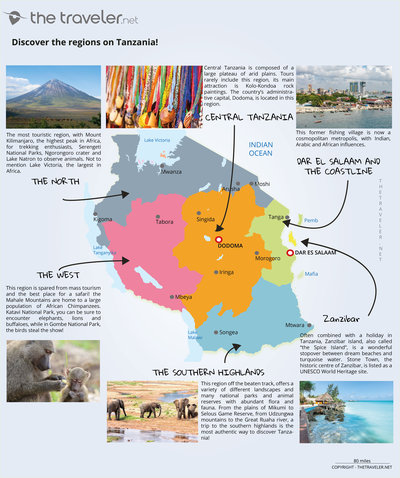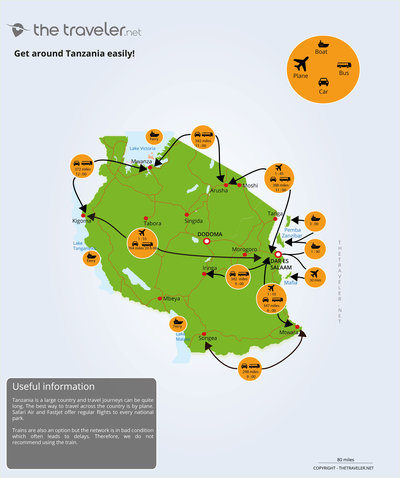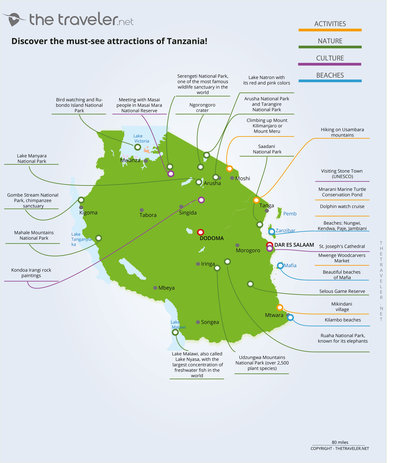Our tourist maps
When people think of East Africa, safaris and the "Big Five" (lion, leopard, elephant, black rhino and buffalo) immediately spring to mind. However, a trip to Tanzania offers so much more! Imagine trekking among the Maasai tribes or around the Ngorongoro Crater in the north of the country, cruising the crystal-clear waters off Zanzibar, trekking to the summit of Mount Kilimanjaro, the highest point in Africa, or travelling aboard a 4x4 looking for the most magnificent animals and birds in the Serengeti National Park. There’s no doubt that nature and animal lovers will find ultimate happiness in Tanzania. It’s a multi-ethnic and multi-cultural country offering a harmonious and welcoming way of life. Zanzibar (“The Spice Island”) with its heavenly beaches, located around 40km off the coast of Tanzania, is usually visited at the same time as a visit to Tanzania.
Region map
Tanzania certainly offers one of the most beautiful wildlife spectacles in the world! But each of its tourist regions has something special to offer. The north is synonymous with mountains, lakes and the majority of the country's most well-known destinations, including the legendary Serengeti National Park. It’s also home to the Maasai tribe, who you will often see around in their traditional red robes. Central Tanzania, home to the administrative capital Dodoma, receives few visitors. Dar El Salaam is a bustling port city, surrounded by superb beaches to the North and South. The south is considered the country's second most popular safari circuit behind the north, a region populated by thousands of animals yet relatively untouched by tourists. Finally, the west of the country, a remote region famous for chimpanzee encounters and Lake Tanganyika, one of the longest lakes on the planet which is nearly 1500 m deep in places!
Overview of 6 tourist regions
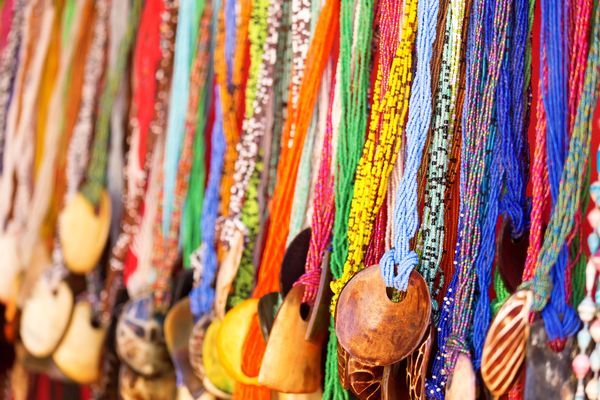
Central Tanzania
The central region is rarely included on tourist itineraries due to its semi-arid climate and poor road network. However, it is the birthplace of some of Tanzania’s people, and there are several sites of interest for curious travellers, including the enigmatic cave paintings of Kolo-Kondoa. This region is also home to many gold and diamond mines; one of the largest diamond mines in the world, the Mwadui Mine, is north of Singida. Dodoma, the country's official capital, is nothing special, but a convenient stopover because of its roads linking Dar Es Salaam and the north of the country.
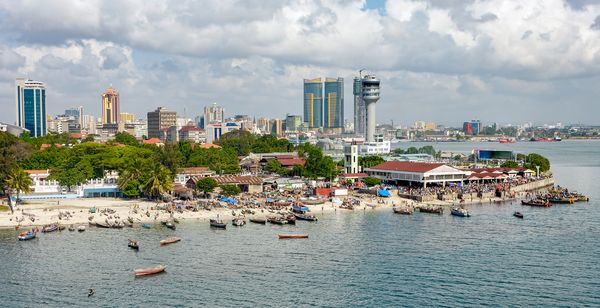
Dar es Salaam and the outskirts
Other than being the administrative capital of the country, the port city of Dar Es Salaam was originally a small fishing village until a sultan established a trading post, after which the small Arab village became a cosmopolitan metropolis teeming with life. It’s the real economic heart of the country. South of the city are stretches of beautiful white sandy beaches lined with palm trees and lapping turquoise waters. Some of the most beautiful beaches include Mikadi Beach, Kipepeo Beach and Ras Kutani beach, magnificent spots for relaxation after a safari. The northern coasts rank close behind; Off the beaten track, they offer some truly amazing discoveries. This corner of Tanzania is unique where the jungle and ocean intertwine.
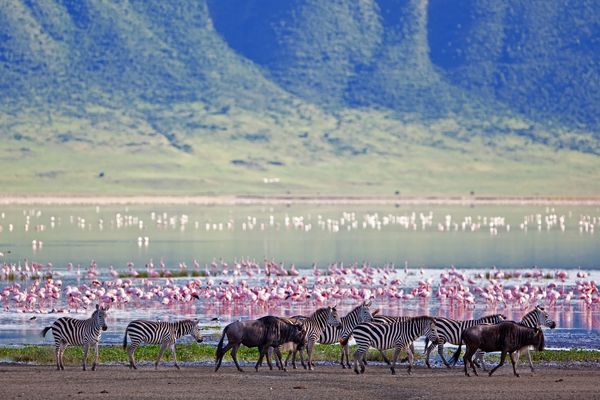
The north and its parks
The northern region is where most safaris are organised, with some of the most famous and visited sites in Tanzania. Some choose to stick to the more well-known sites, such as Lake Victoria, the Serengeti National Park, a game reserve where lions, leopards, baboons, giraffes, wildebeest and other mammals live freely, the Ngorongoro Crater, and a hike or trek up Kilimanjaro, the highest peak in Africa. The northern region offers a multitude of lesser known sites, but they are not really worthy of note; this is the region which deserves most of your attention during a visit to Tanzania.
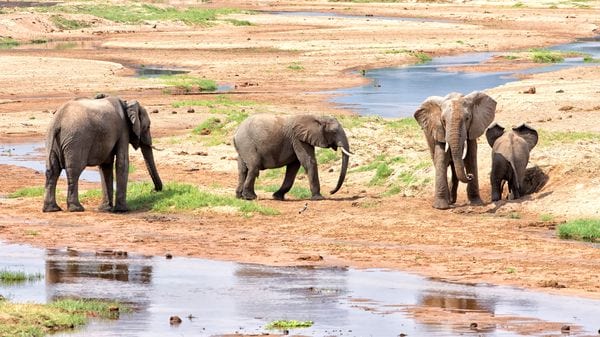
The Southern Highlands
This region is less touristy than the northern region but has many assets and varied landscapes. Green hills, bustling markets and wildlife are among the attractions of the southern highlands. National parks in the region include Mikumi, Ruaha and Selous for wildlife viewing experiences. The beaches of Mtwara and the Mnazi Bay Marine Park are also worth a visit.
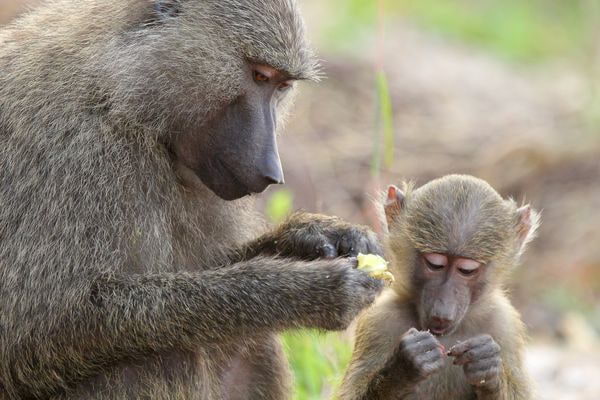
The West
The main asset of this remote area is its nature and wildlife. It’s an ideal destination for seeing chimpanzees, the undisputed rulers of the region. It includes three national parks: Gombe National Park, Mahale Mountains Park and Katavi Park. The city of Tabora is a good stopover during your trip to the west where you will find buildings dating back to the German colonial era. Traveling in this region takes time, the roads are in poor condition.
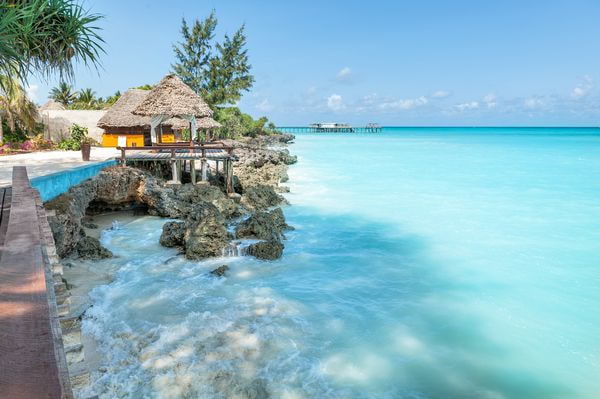
Zanzibar
The Zanzibar Archipelago is only accessible by boat or plane. It’s a semi-autonomous province made up of three islands: Unguja, Pemba and Mafia. Also known as the "spice island" (thanks mainly to cloves), it has a mysterious and romantic atmosphere and idyllic beaches, making it a popular destination for honeymooners, especially along the east coast which boasts white sand, coral reefs and sea temperatures between 26°C and 29°C. Nungwi Beach, Paje Beach and Jambiani Beach are the most beautiful on the island. Stone Town is the name of the historic heart of the city of Zanzibar with its Swahili architecture (wooden doors) still apparent! In the south of the island, in Kizimkazi, you can go on an excursion to admire the humpback dolphins who populate the offshore caves.
Attractions maps
Welcome to Tanzania, a true paradise for wilderness and safari enthusiasts. The country has some fifteen national parks which are home to an extraordinary variety of flora and fauna. Here you’ll have the opportunity to see the "Big Five" in the Serengeti National Park, the best-known safari park in the north of the country. To the south, the Selous Game Reserve and Ruaha National Park are also worthy of a visit. For monkeys and chimpanzees, visit Gombe Stream National Park to the north-west of Lake Tanganyika. There are safaris for all tastes: luxurious safaris in beautiful lodges in the heart of the reserves and even Maasai-guided day safaris in 4x4 vehicles or on foot! The country is also famous for its numerous trekking and hiking routes, the best known being the climb up Mount Kilimanjaro to the roof of Africa. Mount Meru and the Usambara Mountains also offer beautiful panoramas and hikes for all levels of ability.
In terms of culture, the port city of Dar Es Salaam is a cosmopolitan city with an African vibe, the music resonates, the architecture is colonial, and the Swahili culture ever-present. This city will certainly attract your interest and will probably form part of your itinerary. Indeed, it is the starting point for many excursions and for visiting the island of Zanzibar. Here you can enjoy a well-deserved post-safari rest on endless white sandy beaches with crystal-clear waters!
Routes and distances maps
There are many ways to get around during your stay in Tanzania. With a surface area twice as large as France, travel times can be long. The fastest and most comfortable mode of travel is by plane or helicopter. The country has three international airports: Dar Es Salaam, Zanzibar and Kilimanjaro as well as a dozen local airports. Arusha airport, in the north of the country, is very busy; It has regular flights to the Northern National Parks, Zanzibar Island and Dar es Salaam. For those on a tight budget, there are also smaller companies serving national parks and nature reserves with their own airstrips. It costs around 400 euros per person for this type of flight by small plane or helicopter.
Car rental is not commonplace in Tanzania; From a logistical point of view, travel distances are very long and the roads not very reliable. The best option is to rent a 4x4 vehicle with driver.
For travellers who are not in a hurry, take the buses and coaches which serve all parts of the country and which are pretty cheap; it is best to book your tickets in advance. For optimum comfort, opt for the "luxury coaches” on the west side of the country. They are air-conditioned and have a luggage hold. The two best companies in this category are Dar Express and Mtei Express.
Trains are not the best way to travel in Tanzania; the rail network is not well maintained and breakdowns and delays (sometimes up to twelve hours) can ruin your stay.
If there’s one means of transport to try in Tanzania, it's the boat! Sail across the great lakes, such as Lake Victoria and Lake Tanganyika, and marvel at the wonderful views! Boats and ferries are also the most commonly used form of transport for getting to Zanzibar.
Finally, taxis are available in all major cities. They are not equipped with meters, instead rates are negotiated in advance of your journey and usually cost around 1,000 Tsh per kilometre or around 0.40 cents.
You may also like
-
Flights to Tanzania
All you need to know before buying your plane ticket
-
Places to visit in Tanzania
The must-see attractions and the best places to visit Tanzania!
-
Hotel or vacation rental?
Find your dream accommodation in Tanzania at the best price...
-
When to go?
Be sure to visit Tanzania at the best time of year!
and why not...
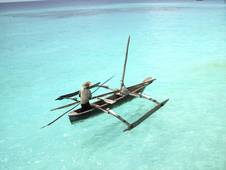 Zanzibar
Zanzibar

